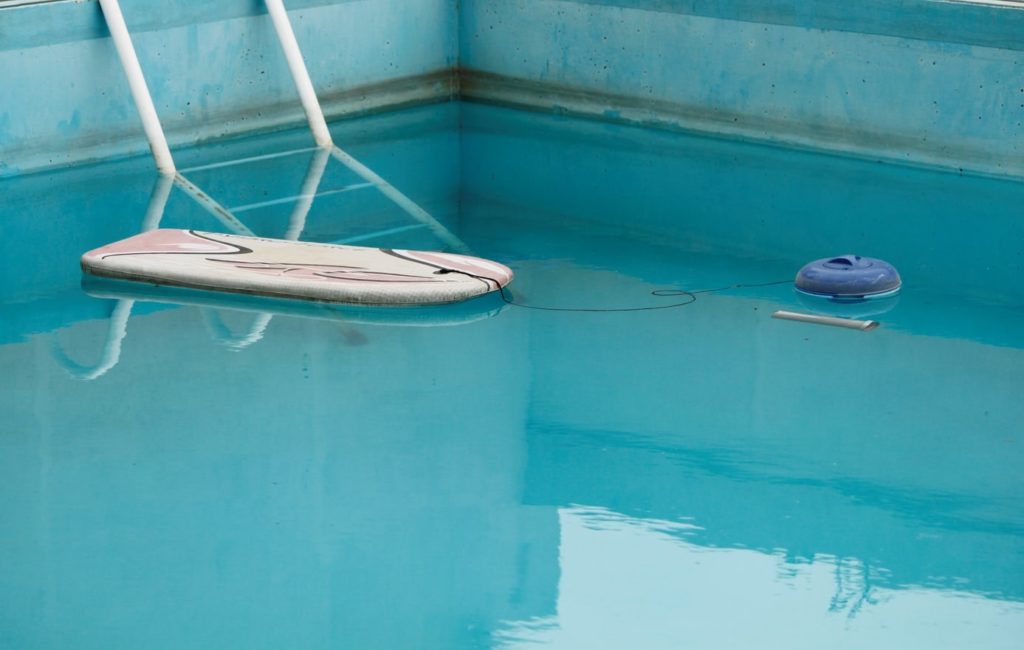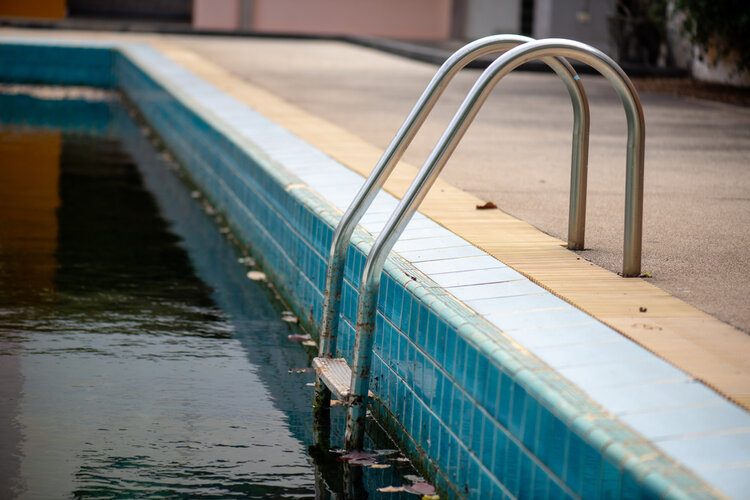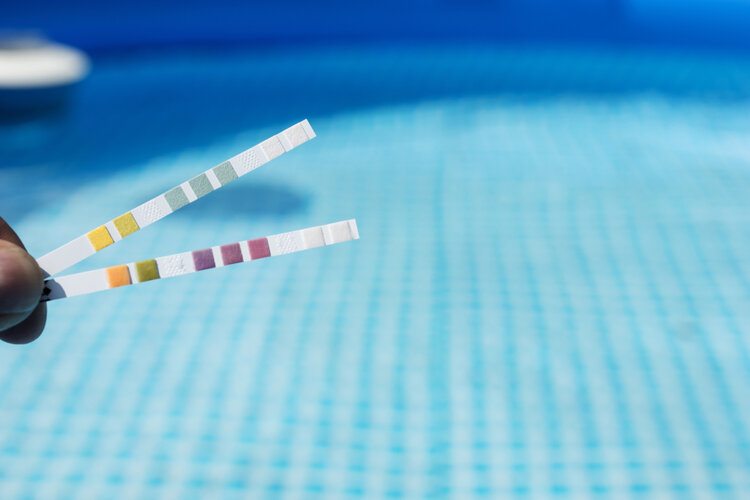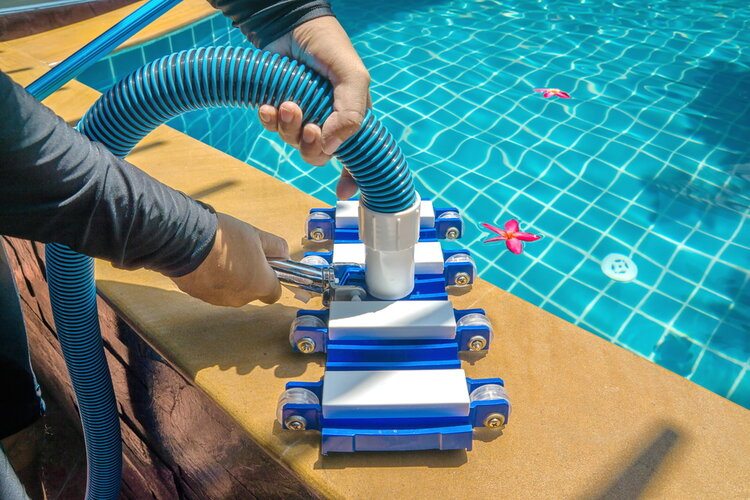How to Remove Black Algae From Your Pool (8 Fast & Easy Steps)
-
- Last updated:


Some types of algae can be easy to remove. Work on your pool pH levels, throw in an algaecide, scrub the side and jump back in.
Unfortunately, removing black algae is going to be a much more extensive process. Prepare to keep the kids and the pets out of the pool for several days. While you are working through the process of getting the pool swimmable again, it is not safe for swimming. Here is our rundown of a fast and easy (as it can be) way of getting the black algae out of your pool.

Is It Safe to Swim If My Pool Has Black Algae?
This question has everything to do with how much water you plan on ingesting while swimming. If you swim in a pool infested with black algae and swallow some of the water, you can get very sick. As we all know, when children swim in the pool, they tend to drink a bit of water. For this reason, its crucial to keep kids out of the pool until the black algae leaves as well.
How Can I Be Sure It Is Black Algae I Have in My Pool?
Unlike yellow or green algae, black algae looks a lot like mold. The fact that it looks like mold is what scares most pool owners, and it should.
- The algae will stick to the wall and does not float around the pool
- When you try and scrub it off its quite difficult
- It seems to all be centralized in a rough area on the pool’s walls (black algae likes to dig in deep)
- Your dog took a swim at the beach and then jumped in the pool!
Why Does My Pool Have Black Algae?

On infrequent occasions, black algae can spread through airborne spores, but the most likely reason is that someone did not wash their bathing suit after swimming in a pond, lake, or the ocean. Keep in mind that sometimes just washing the swimsuits won’t cut it. That kickboard, the goggles, the swim toys—all need to be adequately cleaned before going back to the pool.
Bathing suits going through the washing machine should be fine to use in the pool the next time you swim. For pool toys, goggles, flippers, etc., use a solution of one tablespoon of bleach for one gallon of water to clean the equipment. Anything less will not stop the spread of algae.
Since you are most likely reading this because you already have black algae, let us dive into how to fix this issue.

How to Remove Black Algae From Your Pool
1. Cleaning Time
Clean everything. No, it’s not fun, and it’s going to take some time, but you need to clean everything before you make the problem worse. Clean all pool equipment, filters, brushes, gloves you may use, any pool toys, or floating thermometers that you had in the pool.
Use a half bleach half water solution to clean everything, soap and water will not be enough. When everything is sanitized, you are ready to move to the next step.
2. Test It

Now you need to run some tests on your pool water to establish a baseline. Black algae love high PH, low chlorine, lousy circulation, and filtration. It grows quickest in a warm pool on a sunny day. If your pool levels are off in any way, adjust them before moving to the next step. Your pool chemicals need to be well-balanced before moving to the next step in the removal process.
3. Brush
Brush the pool thoroughly—the entire pool, not just the area with the black algae. If you have a concrete pool, get a heavy-duty brush that will dig into the crevices. Black algae love to get stronger by reaching itself down into the cracks of concrete. Now that it is there, you need to get it out.
Spend a great deal of time scrubbing, and although you may not be able to scrub all of it off, make sure that you have 80-90 % of the algae removed from the surface and in the water.
If you have a vinyl liner in your pool, the brushing process can become a little more complicated. Of course, a heavy-duty wire-bristle brush will ruin your liner and put you into an even worse situation than your current one.
You may need to scrub longer than someone with a concrete pool and carefully apply an appropriate amount of pressure to get the algae loosened and released into the water.
In the areas where you notice the highest infestation of algae, you can use a chlorine tablet to help you while scrubbing. It’s essential to wear a glove while working with a chlorine tablet as not to irritate your skin. The chlorine tablet should help to get the work areas of the black algae loosened.
Once the algae are in the water, the shock treatment will work to start killing it. If you skip the brushing step and leave the algae in the pool, you will not kill all of the algae.
4. Shocking
You may be “shocked” by this, but the pool is going to need a severe shock after this outbreak. A single dose of shock treatment is not going to kill the black algae. We recommend doing a triple or quadruple shock treatment depending on how bad your black algae outbreak is. For those with vinyl liners, be especially careful as shock treatments can sometimes discolor the liner in your pool.
Shocking the pool should be done only at night. If the treatment is done during the day, the sun will make the shock much less effective and cause you to have to do it again. Another trick of the trade is to keep all of those supplies that you just used to clean the pool in it while you shock it.
Guess what? That brush, those gloves, the pole—they all have black algae on them from the work you just completed. Treat this process like a crime scene—do not leave any evidence of that black algae!
5. Run the Pump
A minimum of 24 hours.
The pool will probably still not be clear, and you should not be swimming. Keep the pump going for a minimum of 24 hours before moving to the next step.
6. Brush It Again

While the filter is running during those 24 hours, be sure to keep brushing the pool diligently. At the very least, you are going to want to brush it four times, but six or eight would be even better. We know that at this point in the process, you are ready to snap the pole of the brush over your knee but trust us, you want the algae out and gone forever. Remember, when the Doctor said to complete the entire series of antibiotics, the same goes for black algae removal.
7. More Cleaning (Unfortunately, We Aren’t Kidding)
After all the scrubbing, cleaning, and shocking, it is now time to clean the filter once again. All of the black algae that released into the water can now be hiding in the filter. The last thing you want is to let that grow and infest your pool again. Due to the high levels of chlorine that you used during the shock process, a quick rinse of the filter should be enough. A simple backwash will likely work for most.
After the filter cleaning is completed, treat your pool with a general algaecide. This will help to not only remove the black algae but any other kinds that could be growing as well.
8. Evaluate
For most people at this point, the pool will be back to normal, the water will be clear, and as long as the chlorine as returned to swimmable levels, it could be time to jump back in.
Should you be one of the unlucky ones and you can still see black algae in the pool, you will need to repeat some steps in this process. Very simply, continue the process of clean, scrub, and shock. Pay close attention to how much shock you are using. After the initial triple or quadruple shock, you only need to do a single or double shock.
If you happen to notice a small black algae issue starting after you thought you were in the clear, scrub it with a chlorine tablet and shock the pool. Sometimes this can be enough to stop it before it spreads.
However, if this does not work, be sure to go through the entire process from start to finish again.

Recap
After all is said and done, this really isn’t a difficult process. It is time consuming, frustrating and will keep you out of the pool for at least a couple of days. The general steps are:
- Sanitize
- Scrub
- Shock
Of course, we recommend following the complete process we laid out above, but ultimately, these three things are the simplest and fastest way to remove black algae.
Next time someone tries to rinse off in your pool after a day at the beach, make sure you tell them about the brushing that will be involved should they make that jump!
Keep your pool chemical levels in check, run your pool filter for 8-12 hours a day during the hottest days of the year, and make sure your pH does not get too high. All of these things will keep you from having to deal with this issue ever again.
Related read: How to Get Rid of Mustard Algae (Simple Steps)
Featured Image Credit: irakli kharshiladze, Unsplash
Contents

